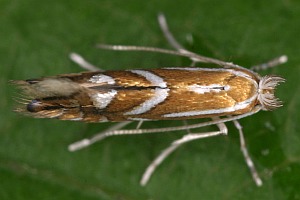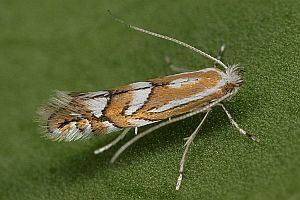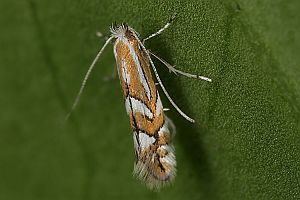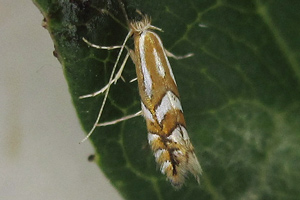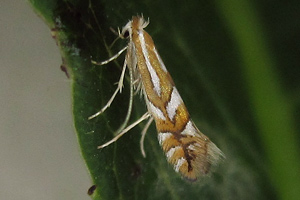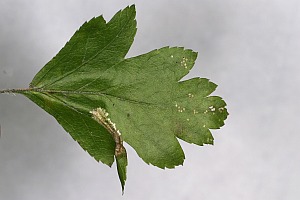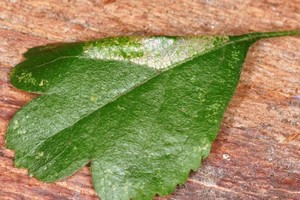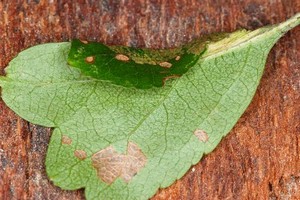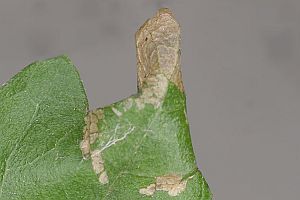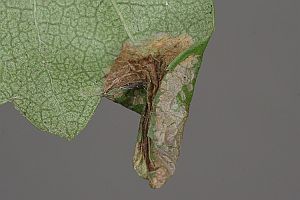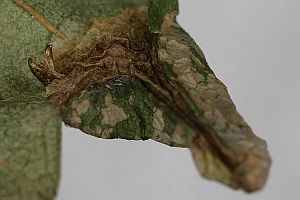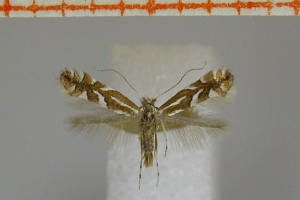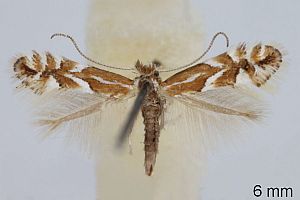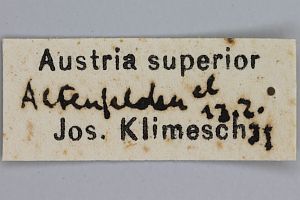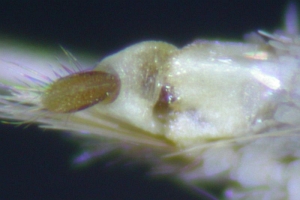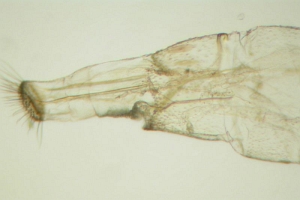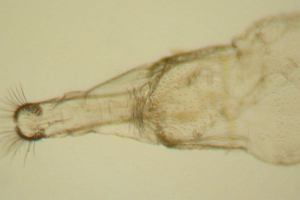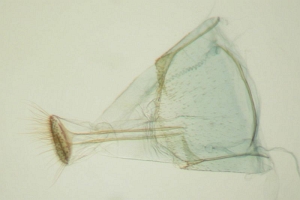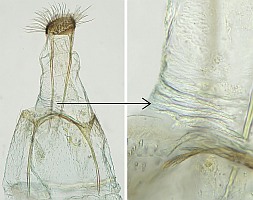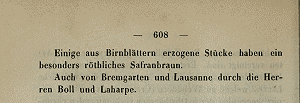

 +30Kontinente:EUAS
+30Kontinente:EUAS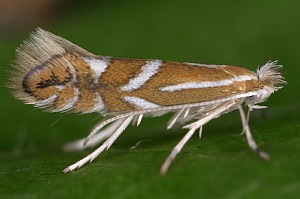


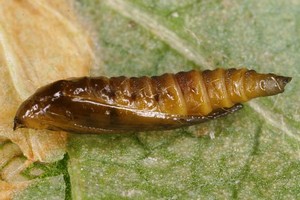
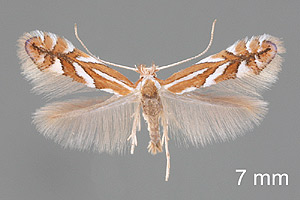
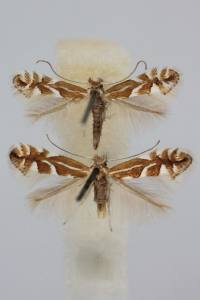

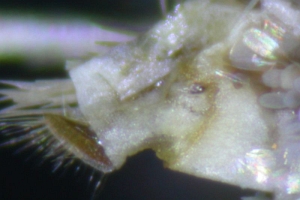

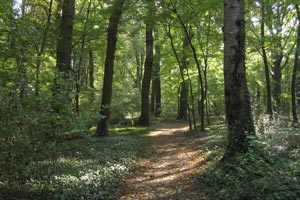
1. Lebendfotos
1.1. Falter
1.2. Raupe
1.3. Fraßspuren und Befallsbild
1.4. Puppe
2. Diagnose
2.1. Weibchen
2.2. Geschlecht nicht bestimmt
2.3. Genitalien
2.3.1. Männchen
2.3.2. Weibchen
2.4. Erstbeschreibung
3. Biologie
3.1. Nahrung der Raupe
- [Rosaceae:] Crataegus monogyna (Eingriffeliger Weißdorn)
- [Rosaceae:] Crataegus laevigata [= Crataegus oxyacantha] (Zweigriffeliger Weißdorn)
- [Rosaceae:] Crataegus pentagyna (Fünfgriffeliger Weißdorn)
- [Rosaceae:] Crataegus crus-galli (Hahnensporn-Weißdorn)
- [Rosaceae:] Crataegus chrysocarpa [= Crataegus rotundifolia] (Rundblättriger Weißdorn)
- [Rosaceae:] Crataegus pedicellata [= Crataegus intricata] (Scharlach-Weißdorn)
- [Rosaceae:] Crataegus rhipidiphylla [= Crataegus calycina subsp. curvisepala] (Großkelch-Weißdorn)
- [Rosaceae:] Crataegus rivularis
- [Rosaceae:] X Crataegomespilus arnieresi
- [Rosaceae:] Mespilus germanica (Echte Mispel)
- [Rosaceae:] Chaenomeles japonica (Japanische Zierquitte)
- [Rosaceae:] Pyracantha coccinea (Feuerdorn)
- [Rosaceae:] Pyrus communis (Kultur-Birne)
- [Rosaceae:] Pyrus pyraster (Wild-Birne)
- [Rosaceae:] Sorbus torminalis (Elsbeere)
- [Rosaceae:] Sorbus aucuparia (Eberesche)
- [Rosaceae:] Staphylea pinnata (Pimpernuss)
Die Art miniert unterseitig an Eingriffeligem Weißdorn (Crataegus monogyna) [Bradley, Jacobs & Tremewan (1970)]. Sie ist aber auch an vielen anderen Weißdorn-Arten zu finden, sehr viel seltener auch an Birnen und anderen Rosaceen.
3.2. Habitat
4. Weitere Informationen
4.1. Andere Kombinationen
- Lithocolletis oxyacanthae Frey, 1856 [Originalkombination]
4.2. Synonyme
- Lithocolletis pomonella Zeller, 1846
- Phyllonorycter pomonella (Zeller, 1846)
4.3. Nomenklatur
Triberti (2007) kommt zum Schluss, dass Phyllonorycter pomonella Zeller, 1846, identisch mit der erst 10 Jahre später beschriebenen P. oxyacanthae ist. Er empfiehlt allerdings, den Namen P. oxyacanthae als nomen conservandum zu fixieren, da er seit sehr lamgem im Gebrauch ist und der Name "P. pomonella" nur selten gebraucht wurde und dabei auch noch für diverse andere Arten der Gattung Verwendung fand, so vor allem für P. cydoniella. Der Sachverhalt wurde im Bulletin of Zoological Nomenclature 64(2) June 2007 diskutiert [Bulletin ZN] .
In “The Bulletin of Zoological Nomenclature (BZN) Volume 64, Part 2, 30 June 2007” ist dazu zu lesen: [BZN Case 3376]
“Lithocolletis oxyacanthae Frey, 1855 (currently Phyllonorycter oxyacanthae; Insecta, Lepidoptera): proposed conservation of the specific name by giving it precedence over Lithocolletis pomonella Zeller, 1846.
Paolo Triberti c/o Museo Civico di Storia Naturale, Lungadige Porta Vittoria 9, I-37129 Verona, Italy (e-mail: caloptilia@alice.it). Abstract. The purpose of this application, under Article 23.9.3 of the Code, is to conserve the widely used specific name Phyllonorycter oxyacanthae (Frey, 1855) for a common European leaf miner moth (family GRACILLARIIDAE) by giving it precedence over Phyllonorycter pomonella (Zeller, 1846), which has recently been shown by Triberti (2007) to be its senior synonym. A change in the application of the name would cause considerable confusion as the name P. pomonella has been commonly applied to other species.”
In “The Bulletin of Zoological Nomenclature (BZN) Volume 65, Part 3, 30 September 2008” findet sich dann unter “OPINION 2205” [BZN Opinion 2205] “Lithocolletis oxyacanthae Frey, 1855 (currently Phyllonorycter oxyacanthae; Insecta, Lepidoptera): specific name conserved. Abstract. The Commission has ruled that the specific name Lithocolletis oxyacanthae Frey, 1855 is conserved for a European leaf-mining moth by giving it precedence over the senior synonym Lithocolletis pomonella Zeller, 1846."
Als Jahreszahl der Arbeit von Frey wurde meist "1856" genannt, so auch in den Listen von Karsholt & Razowski (1996) und der Fauna Europaea, last update 23 July 2012, version 2.5 [nicht mehr zugänglich]. Wir folgen hier der Opinion der BZN und datieren sie auf 1855.
(Autor: Erwin Rennwald)
4.4. Literatur
- Erstbeschreibung: Frey, H. (1855): Ueber die in der Schweiz beobachteten Arten des Genus Lithocolletis Zell. — Mittheilungen der Naturforschenden Gesellschaft in Zürich 3: 600-635.
- Frey, H. (1856): Die Tineen und Pterophoren der Schweiz. 1-430 (hier S. 336). Zürich (Meyer und Zeller).
- SCHÜTZE (1931): 100
- Triberti, P. (2007): The Phyllonorycter species from Palaearctic Region feeding on Rosaceae (Lepidoptera, Gracillariidae). — Bollettino del Museo Civico di Storia Naturale di Verona 31: 147-221 [PDF auf museostorianaturaleverona.it].































